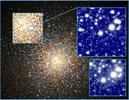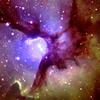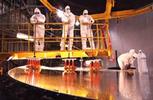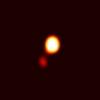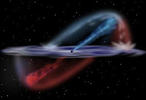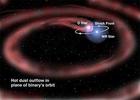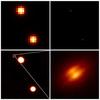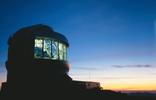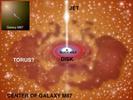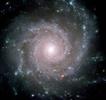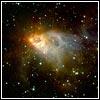Gemini News Archive
New Gemini Images Exemplify the Power of Adaptive Optics
Press Release | 2003 June 2
A razor-sharp image was released today revealing new details at the heart of a famous star cluster M-13, taken with adaptive optics system Altair on Gemini North.
Gemini Telescope on Mauna Kea Named in Honor of Dr. Frederick C. Gillett
Press Release | 2002 November 13
Gemini Observatory honored Dr. Fred Gillett, a pioneer in infrared astronomy, by naming the Gemini North Telescope in his honor at ceremonies at the telescope on Mauna Kea, Hawai'i, November 13, 2002.
New Internet Link Moves Gemini a Step Closer to Becoming World's First "Cyber Observatory"
Press Release | 2002 August 13
With funding and support from NSF, Gemini has succeeded in blazing a new Internet pathway which will provide its globally separated twin telescopes with a reliable data transfer connection able to handle the enormous amounts of scientific information created by Gemini's sophisticated instrumentation.
Serendipitous Science
Press Release | 2002 June 20
A thirteen-year-old Vancouver, girl's proposal to take a picture ofthe Trifid Nebula by the Gemini Observatory is prompting a closer lookat this star-forming region.
High-Tech Horse Sense
Press Release | 2002 June 4
Technicians use common horse soap to clean the 8-meter (26-foot) mirror of Gemini North Telescope atop Mauna Kea.
Closest Brown Dwarf Companion Ever Spotted Around a Star Provokes New Perspective
Press Release | 2002 May 21
Astronomers using adaptive optics technology on the Gemini North Telescope have observed a brown dwarf orbiting a low-mass star at a distance comparable to just three times the distance between the Earth and Sun.
Gemini Observatory Captures Multi-Dimensional Movie of Active Galaxy's Core
Press Release | 2002 March 21
Using the recently commissioned IFU on GMOS, astronomers have recently obtained a complete multi-dimensional picture of the dynamic flow of gas and stars at the core of an active galaxy named NGC 1068 in a single snap-shot.
Massive Star Pair Raises Dust While Doing the Tango
Press Release | 2002 February 25
A team using the Gemini Observatory has released tantalizing evidence that tiny dust particles ejected by hot, massive stars, may survive long enough to reach the interstellar medium, which might have provided some of the materials necessary for the early formation of planetary systems in the young Universe.
Gemini Observatory Celebrates Historic First for Observational Astronomy
Press Release | 2002 January 18
Gemini South, the second of the Gemini telescopes to look skyward, was dedicated on its perch on Cerro Pachón in the Chilean Andes.
Brown Dwarf Found Around Nearby, Sun-Like Star
Press Release | 2002 January 7
Astronomers using adaptive optics on the Gemini North and Keck telescopes have taken an image of a brown dwarf orbiting a nearby star similar to the Sun.
Astronomers Discover Edge-On Protoplanetary Disk in Quadruple Star System
Press Release | 2002 January 7
Astronomers using the recently commissioned Gemini North telescope have discovered a protoplanetary disk orbiting one of the stars in a newborn quadruple star system.
Media Invited to Gemini South Dedication January 18, 2002, La Serena and Cerro Pachón, Chile
Press Release | 2001 December 3
On January 18, 2002, the Gemini Observatory will celebrate a significant milestone with the dedication of the Gemini South telescope facility at the summit of Cerro Pachón, Chile.
Gemini Observation Deepens Mystery of Local Active Galaxy
Press Release | 2001 October 29
In the deepest ground-based mid-infrared image ever, the Gemini North Telescope reveals that the mysterious environment around one of the most massive black holes in the Universe is missing a key feature predicted by astronomical theory.
Gemini Observatory Captures "Perfection" With Early Image From New High-Tech Instrument
Press Release | 2001 October 2
GMOS image of the large galaxy in Pisces called NGC 628 (or Messier 74), the "Perfect Spiral Galaxy," is released.
Gemini Spies Strong Stellar Gusts in Nearby Massive Star
Press Release | 2001 July 23
The infrared image, taken by the Gemini North telescope on Hawaii's Mauna Kea, reveals remarkable details in a nebula of gas and dust expelled from a young star named AFGL 2591.
Gemini Cuts Deep Into Galactic Core with Release of First Data
Press Release | 2000 October 16
The first scientific observations from the Gemini North telescope provide a dramatic glimpse into the elusive core of the Milky Way, including an intriguing bow-shock from a star as it plows into a poorly understood gas cloud a mere 3 light-years from the galactic center.
8.1-Meter Mirror Crosses Oceans to Reach Gemini Telescope
Press Release | 2000 March 20
After traveling in the shadow of the Eiffel Tower, through the Panama Canal and up a steep, narrow mountain road to a remote peak in Chile, the mirror arrived safely at the Gemini South Observatory on March 17th, 2000.
New Telescope Gives Astronomers a Clearer Vision of the Universe
Press Release | 1999 June 25
At the dedication ceremony on Mauna Kea today, astronomers revealed some of the sharpest infrared images ever obtained by a ground-based telescope.
Gemini Observatory Receives Funding to Take Mauna Kea Internet Access to New Heights
Press Release | 1999 April 15
The Gemini Observatory has received NSF funding to support a significant expansion of the internet connection speed between its Mauna Kea observatory, its Hilo headquarters in University Park, and the rest of the world.
Gemini Observatory on Hawaii's Mauna Kea Reaches Several Milestones
Press Release | 1998 December 23
Over the past two weeks, the Gemini North telescope near the summit of Hawaii's Mauna Kea has succeeded in accomplishing several key steps in the completion of this state-of-the-art 8-meter telescope facility.
